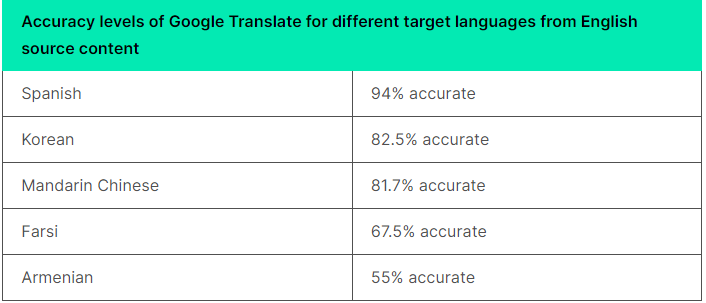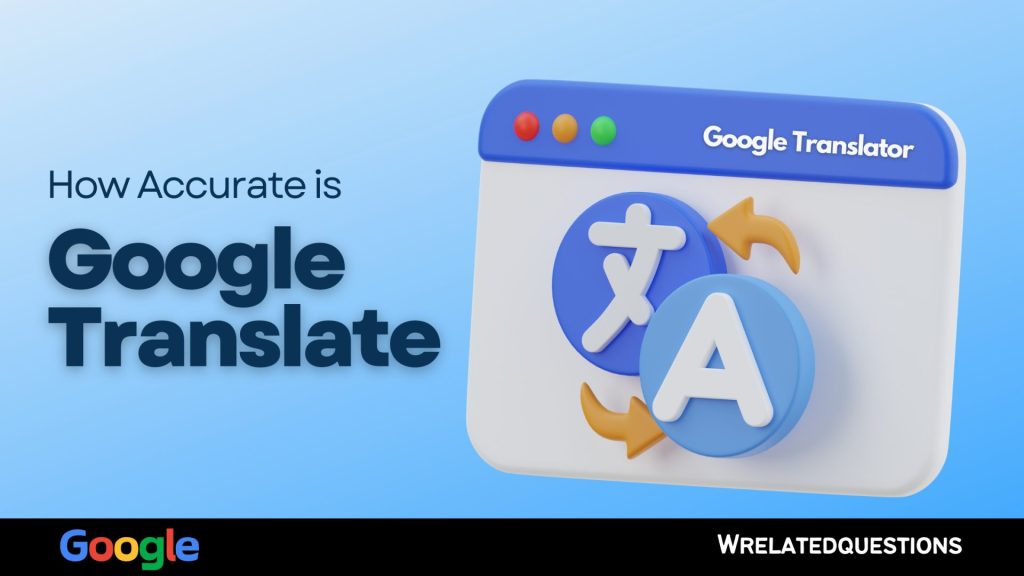People curious about Is Google Translate accurate. and if it is, then how much? Is it 53% or 87% and 91%, well everything will be clear in this post so stay with us.
Google Translate is useful for basic communication and language understanding.
Despite its value, it’s essential to recognize its limitations and exercise caution, particularly with critical or sensitive information. I
In such cases, opting for professional human translation is considered the best and most reliable choice.
Is Google Translate AI?
Google Translate employs artificial intelligence, specifically a neural machine translation (NMT) system called Google Neural Machine Translation (GNMT), introduced in November 2016.
GNMT utilizes an artificial neural network with encoder and decoder blocks to enhance the fluency and accuracy of translations.
Deep learning techniques enable the translation of entire sentences simultaneously, proving more effective for certain languages.
While Google Translate is widely recognized as the leading AI translation platform, human intervention remains crucial for further improving its performance.
Is Google Translate API free?
The Google Translate API is not free and is priced based on monthly usage, measured in millions of characters.
The cost is $20 per 1 million characters for translation or language detection.
The API has default limits of 2 million characters per day and 100,000 characters per 100 seconds, which can be increased to 50 million characters per day.
To access the API, users need to create a Google Translate API Key through the Google Cloud Console, requiring card information.
However, there is a free tier limit of 500,000 translated characters per month.
The charges vary depending on the API methods and the chosen translation model, and all prices are listed in US dollars (USD).

img source: phrase
is the Google Translate app free?
Google Translate is a top-notch translation application, that offers language translation services for free.
Its user-friendly interface is both attractive and smooth, enhancing the overall user experience.
Is Google Translate an app?
The Google Translate app, available for Android and iOS, supports 133 languages.
It can suggest translations for 37 languages through photo translation, 32 via voice in “conversation mode,” and 27 through live video imagery in “augmented reality mode.”
Is Google Translate offline?
To use languages offline in the Google Translate app, you must download each language beforehand, requiring an internet connection during the download process.

img source: phrase
Is Google Translate Mexican Spanish?
Google Translate offers support for different language variants, including Mexican Spanish.
Users have the flexibility to choose their preferred Spanish variant for translation.
However, it’s essential to recognize that there may be nuances or differences between regional variations of Spanish.
To cater to specific dialects or regional preferences, users can select their desired language variant in the settings of the Google Translate app.
Does Google translate Kurdish sorani?
In May 2022, Google Translate achieved a significant milestone by including Sorani Kurdish among its translation languages.
This addition, comprising 24 new languages, holds particular significance for the Kurdish people, who have historically sought recognition and sovereignty.
Is Google Translate a Chrome extension?
To use the Google Translate extension on Chrome, find it in the Chrome Web Store, click “ADD TO CHROME,” and then highlight a word on any webpage.
Click on the extension icon (a puzzle piece) in the top-right corner to access and utilize the Google Translate extension.
Is Google Translate accurate?
A 2014 study revealed that Google Translate had a 57.7% accuracy rate in translating complex medical phrases.
In a 2021 study by the UCLA Medical Center, it was found that Google Translate maintained the overall meaning in 82.5% of translations.
However, Google translate is the accuracy varied widely between languages, ranging from 55% to 94%.
Which translator is 100% accurate?
Currently, no translator, including highly regarded tools like DeepL, achieves 100% accuracy.
Machine translation tools face challenges with nuances, context, specialized content, and rare languages or dialects.
While popular tools like DeepL, Google Translate, and Microsoft Translator continuously improve, they still have limitations.
These tools leverage large datasets, statistical models, and human feedback to enhance accuracy.
The choice of the “best” translator depends on factors like language pair, content type, and the balance between accuracy and fluency in translations.

How accurate is Google Translate in 2024?
In 2021, studies showed that Google Translate had an average accuracy rate of 82.5%, varying from 55% to 94% based on language pairs.
Common languages like English-Spanish had higher accuracy (around 90%), while less common pairs like English-Armenian were less accurate (around 55%).
Factors influencing accuracy include language pair, content type, sentence structure, and cultural references.
Google Translate is free, widely available, and continually improving, offering features like voice and document translation.
However, it has limitations, including not being perfect for formal or critical use, lacking nuance and cultural understanding, and not being ideal for creative writing.
While valuable for basic communication, it’s crucial to recognize these limitations and exercise caution in critical or sensitive situations, where professional human translation is recommended.
What mistakes does Google Translate make?
Google Translate, though powerful, is susceptible to various types of mistakes.
Common issues include contextual misinterpretations such as missing nuance, literal translations of idioms, and overlooking grammatical features.
Technical limitations manifest in errors with rare languages, struggles with technical jargon, and susceptibility to mistakes due to spelling errors.
Other issues involve cultural insensitivity, the balance between fluency and accuracy, and the lack of human quality control.
It’s essential to be aware of these limitations, and while user feedback helps enhance algorithms, human review remains crucial for achieving optimal accuracy.
How do I improve Google Translate accuracy?
To enhance the accuracy of Google Translate for specific needs, consider the following tips:
1. Before translation:
Proofread source text: Correct grammar errors and typos to avoid confusion in the algorithm.
Choose the right language pair: Opt for common language pairs with more training data for better performance.
Consider context: Provide additional context details, such as audience and purpose, for more accurate translations.
Simplify complex sentences: Break down long and convoluted sentences into shorter, clearer ones.
2. During translation:
Use alternate translations: Consider alternative translations suggested by Google Translate for more accurate meanings.
Provide feedback: Submit corrections or suggestions to help improve the algorithm.
Compare with other tools: Compare results with alternative translation tools for a more comprehensive understanding.
3. After translation:
Proofread translated text: Carefully review the translation for errors or inaccuracies.
Consult native speakers: For critical translations, have a native speaker review for fluency and accuracy.
Use human translation for sensitive information: Opt for professional human translation for legal, medical, or sensitive documents.
Is Google Translate good for learning?
Use of Google Translate for language learning when combined with other methods. Here are additional insights on its benefits, limitations, and effective use:
Benefits for learning:
1. Exposure to authentic language: Offers real-world language examples from various contexts, enhancing engagement.
2. Visualization and pronunciation aid: Simultaneous audio and written translation support memorization and pronunciation practice.
3. Overcoming beginner hurdles: Translating simple phrases provides a sense of accomplishment, boosting confidence.
4. Motivational tool: Progress in understanding translated content can motivate ongoing language exploration.
Limitations for learning:
1. Oversimplification: Translations may lack nuances, leading to incomplete or inaccurate understanding.
2. Grammar dependence: Focuses on word-level translations, potentially hindering grasp of grammar rules.
3. Passive learning: Overreliance may discourage active development of speaking and writing skills.
4. Lack of feedback: Unable to provide personalized feedback on pronunciation or grammar mistakes.
Effective use for learning:
1. Focus on basic comprehension: Use for understanding general meaning in simple texts, not relying solely on accuracy.
2. Verify translations: Cross-reference with other sources to ensure a more comprehensive understanding.
3. Active learning: Use translations as a starting point to engage actively with the language, construct sentences, and participate in conversations.
4. Set boundaries: Avoid reliance on Google Translate for complex material or precise communication, using it as a supplement rather than a replacement for dedicated language learning.
Conclustion
In summary, the accuracy of Google Translate varies depending on factors such as language pair, content type, sentence structure, and cultural references.
Studies suggest an average accuracy of around 82.5%, with common languages achieving higher accuracy than rarer ones.
Google Translate is free, widely available, and continually improving, offering additional features like voice and document translation.
However, it has limitations, including potential errors in formal or critical use, a lack of nuance in cultural understanding, and challenges in capturing the complexity of creative writing.
While valuable for basic communication, users should be cautious with critical or sensitive information and consider professional human translation in such cases.
nderstanding Google Translate’s strengths and limitations allows for effective utilization in language communication needs as it evolves over time.
